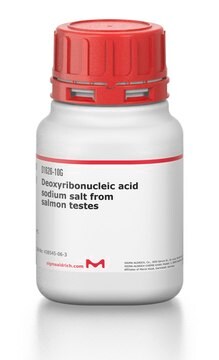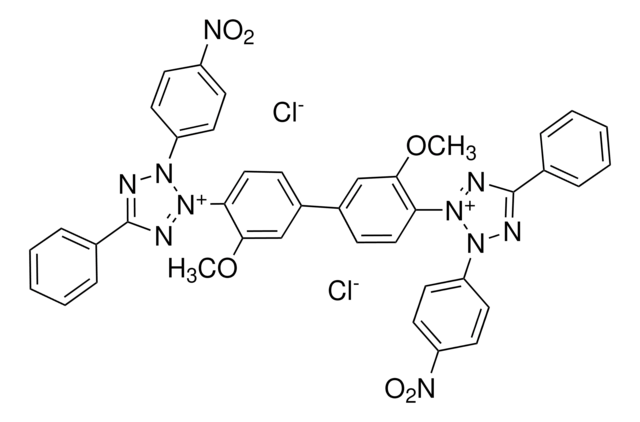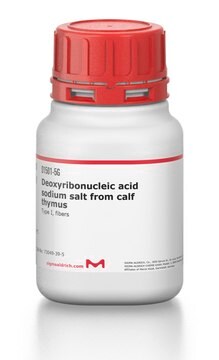T6632
Thymidine Phosphorylase, recombinant from Escherichia coli
recombinant, expressed in E. coli, buffered aqueous solution, ≥900 units/mL, 0.2 μm filtered
Sinónimos:
Thymidine:orthophosphate deoxy-D-ribosyltransferase
Iniciar sesiónpara Ver la Fijación de precios por contrato y de la organización
About This Item
Número de CAS:
Número MDL:
Código UNSPSC:
12352204
NACRES:
NA.54
Productos recomendados
recombinante
expressed in E. coli
Nivel de calidad
esterilidad
0.2 μm filtered
Formulario
buffered aqueous solution
concentración
≥900 units/mL
Nº de acceso UniProt
temp. de almacenamiento
2-8°C
Información sobre el gen
Escherichia coli K12 ... deoA(948901)
¿Está buscando productos similares? Visita Guía de comparación de productos
Descripción general
Thymidine phosphorylase inhibits vascular smooth muscle cell proliferation.
Aplicación
Thymidine phosphorylase has been used in a study to evaluate biomarkers for advanced breast cancer patients treated with capecitabine-based first-line chemotherapy. Thymidine phosphorylase has also been used in a study to investigate implications for the clinical efficacy of nucleoside analogues.
Acciones bioquímicas o fisiológicas
An enzyme that catalyzes the reversible conversion of thymidine to thymine. Thymidine phosphorylase is part of the pyrimidine nucleoside salvage pathway. This pathway allows pyrimidine bases to be recycled for nucleotide biosynthesis, while the pentose 1-phosphates are converted to intermediates of the pentose phosphate shunt and glycolysis. The E. coli thymidine phosphorylase shares 40% sequence homology with the human sequence, which has been found to be identical to the angiogenic agent platelet-derived endothelial growth factor. The purified E. coli enzyme has been shown to stimulate blood vessel growth in chick chorioallantoic membrane assays.
Definición de unidad
One unit will convert 1.0 μmole each of thymidine and phosphate to thymine and 2-deoxyribose 1-phosphate per min at pH 7.4 at 25°C.
Forma física
Solution in 0.5 M potassium phosphate containing 2 mM uracil, 0.02% sodium azide and bovine serum albumin
Nota de preparación
Cloned from E. coli and produced in overexpressing E. coli
Código de clase de almacenamiento
12 - Non Combustible Liquids
Clase de riesgo para el agua (WGK)
WGK 2
Punto de inflamabilidad (°F)
Not applicable
Punto de inflamabilidad (°C)
Not applicable
Equipo de protección personal
Eyeshields, Gloves, multi-purpose combination respirator cartridge (US)
Elija entre una de las versiones más recientes:
¿Ya tiene este producto?
Encuentre la documentación para los productos que ha comprado recientemente en la Biblioteca de documentos.
Domenico Ribatti et al.
Expert opinion on therapeutic targets, 16(12), 1215-1225 (2012-09-18)
Several anti-angiogenic agents have been developed and some of them have been clinically applied in the tumor therapy. Anti-angiogenic therapy faces some hurdles: inherent or acquired resistance, increased invasiveness, and lack of biomarkers. Characterization of tumor endothelial markers may help
Richard A Norman et al.
Structure (London, England : 1993), 12(1), 75-84 (2004-01-17)
Human thymidine phosphorylase (HTP), also known as platelet-derived endothelial cell growth factor (PD-ECGF), is overexpressed in certain solid tumors where it is linked to poor prognosis. HTP expression is utilized for certain chemotherapeutic strategies and is also thought to play
Alexandra Giatromanolaki et al.
Cancer biology & therapy, 13(13), 1284-1289 (2012-08-17)
Tumor-associated stroma (TAS) is not simply a supporting element for cancer cells, but plays an important role in tumor growth, invasion and metastasis. Changes on the level of stromal constituents, such as loss of Caveolin-1 and increased thymidine phosphorylase (TP)
Hong-Yun Zhao et al.
Anti-cancer drugs, 23(5), 534-542 (2012-04-07)
The aim of the present study was to investigate the gene expression of biomarkers associated with the sensitivity to fluoropyrimidine and taxanes in recurrent/advanced breast cancer patients treated with first-line capecitabine chemotherapy. We evaluated the clinicopathological/prognostic significance of thymidylate synthase
Michelle Levene et al.
Toxicological sciences : an official journal of the Society of Toxicology, 131(1), 311-324 (2012-09-15)
Erythrocyte-encapsulated thymidine phosphorylase (EE-TP) is currently under development as an enzyme replacement therapy for mitochondrial neurogastrointestinal encephalomyopathy (MNGIE), an autosomal recessive disorder caused by a deficiency of thymidine phosphorylase. The rationale for the development of EE-TP is based on the
Nuestro equipo de científicos tiene experiencia en todas las áreas de investigación: Ciencias de la vida, Ciencia de los materiales, Síntesis química, Cromatografía, Analítica y muchas otras.
Póngase en contacto con el Servicio técnico







